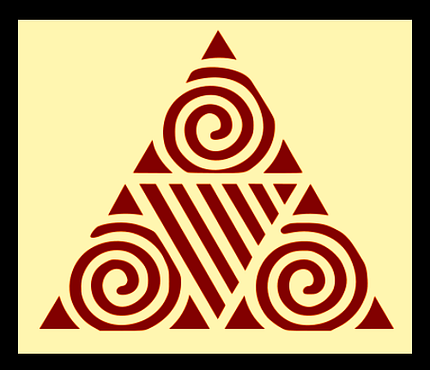Indigenous Spirituality Features
+
1. Cherokee Religion (North America)
The Cherokee traditionally believed in a singular, omnipresent creator called *Unetlanvhi* ("Great Spirit" or "Creator"), viewed as a divine force with no human form. While lesser spirits govern natural phenomena, Unetlanvhi’s centrality aligns with monotheistic principles.
+
2. Lakota/Dakota Sioux (North America)
The concept of **Wakan Tanka** ("Great Mystery" or "Great Spirit") is often interpreted as a supreme, all-pervading divine force. While Wakan Tanka encompasses many spiritual manifestations (e.g., sun, earth), some scholars and practitioners describe it as a singular, unified power governing the cosmos.
+
3. Algonquian Peoples (North America)
The *Gitche Manitou* ("Great Spirit") is revered as a supreme creator and sustainer of life. Though Algonquian traditions include spirits like the Windigo or animal guides, Gitche Manitou’s primacy reflects monotheistic undertone..
+
4. Iroquois Confederacy (North America)
The *Ha-wen-ne-yu* ("Great Spirit") is a singular creator deity who governs the universe. While subordinate spirits exist, early ethnographic accounts describe Iroquois religion as monotheistic, with Ha-wen-ne-yu as the ultimate authority.
+
5. Haitian Vodou (Caribbean)
Vodou teaches the existence of *Bondye* (from French *Bon Dieu*, "Good God"), a transcendent, omnipotent creator. Though Vodou veneration focuses on intermediary spirits (*lwa*), Bondye’s role as the sole supreme being aligns with monotheism.
+
6. Bukongo (Kongo People, Central Africa)
The Kongo tradition centers on *Nzambi a Mpungu Tulendo*, a supreme God who created the universe. While ancestors and natural forces are revered, they are intermediaries, not independent deities. This hierarchical structure is explicitly monotheistic.
+
7. Bon (Tibet)
Bon posits a triad of cosmic gods (*Dagpa*, *Salba*, *Shepa*) controlling past, present, and future. However, these are often interpreted as manifestations of a singular divine force. Bon’s syncretic merger with Buddhism later emphasized a unified cosmic order.
+
8. Anishinaabe (North America)
The *Gichi-manidoo* ("Great Spirit") is a central, formless creator in Anishinaabe cosmology. While nature spirits (*manidoog*) are acknowledged, Gichi-manidoo’s omnipresence reflects monotheistic qualities.
+
9. Shawnee (North America)
The Shawnee tradition includes *Moneto*, a supreme deity associated with creation and spiritual power. Though lesser spirits exist, Moneto’s supremacy parallels monotheistic frameworks.
+
10. Aztec Philosophy (Mesoamerica)
Some scholars argue that Aztec theology conceptualized *Teotl* as a singular, pantheistic divine force underlying all existence. While the populace worshipped many gods, priestly classes may have viewed these as facets of Teotl.
+
Key Notes:
- Ambiguity in categorization: Many Indigenous traditions blend monotheism with animism or polytheism, resisting rigid Western labels. For example, Wakan Tanka and Gitche Manitou are both singular and plural, reflecting a holistic worldview.
- Syncretism: Post-colonial influences (e.g., Christianity) sometimes reshaped Indigenous beliefs, complicating interpretations of pre-contact monotheism.
- Cultural diversity: These examples span continents and cultures, illustrating that monotheistic concepts are not exclusive to Abrahamic religions.

Did Native Americans’ wars and disputes with each other ever involve spiritual beliefs?
Native American tribes sometimes fought each other, and while most intertribal wars were driven by practical concerns such as territory, resources, revenge, and historical rivalries, spiritual and religious beliefs also played a role in some conflicts.
+
Spiritual and Religious Dimensions in Native Warfare
• Spiritual Significance of Warfare: Warfare among Native American tribes was often deeply intertwined with spiritual beliefs and rituals. Many tribes conducted purification ceremonies, invoked spiritual powers, and believed that success in battle depended on spiritual favor or the fulfillment of ritual obligations. The act of going to war, the rituals before and after battle, and even the treatment of captives could all have spiritual meaning.
+
• Mourning Wars: In the Eastern Woodlands, tribes engaged in “mourning wars,” which were partly spiritual in nature. These wars were fought to avenge the death of kin, restore spiritual balance, and ease communal grief.
Taking captives could replace lost members and restore the tribe’s spiritual strength, and sometimes captives were used in ritual sacrifices. Thus, the motivation for these wars was not just revenge or demographic need, but also a spiritual imperative to restore harmony after a loss.
+
• Conflicts Over Beliefs and Practices: Differences in religious beliefs and cultural practices could also lead to misunderstandings and hostilities between tribes. Some tribes viewed the ceremonies or customs of their neighbors as wrong or immoral, which could exacerbate tensions and lead to conflict.
While outright wars solely over differing spiritual doctrines are not widely documented, clashes over religious practices, taboos, or sacred sites sometimes contributed to intertribal animosity.
+
Other Major Causes of Intertribal Conflict
• Territorial Disputes: Competition for land, hunting grounds, and resources was a primary cause of warfare.
• Revenge and Blood Feuds: Cycles of retaliation for past injuries or deaths were common.
• Economic Competition and Power Struggles: Control over trade routes, goods, and regional influence also led to conflict.
+
Below are three specific examples where differences in religious beliefs and cultural practices contributed to misunderstandings and hostilities between Native American tribes:
• Conflicts Over Sacred Sites: The Bears Ears region in Utah is sacred to multiple tribes, including the Hopi, Navajo, Ute Mountain Ute, Ute Indian Tribe, and Pueblo of Zuni.
These tribes have sometimes had differing views on how the land should be used, managed, and protected, leading to disagreements and the need for intertribal coalitions to resolve disputes over access, ritual use, and stewardship of these spiritually significant places.
The land’s religious significance and the different ceremonial practices associated with it have at times created tension among the tribes.
+
• Mourning Wars and Ritual Practices: Among Eastern Woodlands tribes, such as the Iroquois and their neighbors, mourning wars were fought to avenge the dead and restore spiritual balance.
These wars were rooted in distinct beliefs about death, the afterlife, and the spiritual necessity of replacing lost community members, often through the capture of outsiders.
Neighboring tribes who did not share these beliefs or who saw the practice as immoral could become targets or respond with violence, escalating cycles of conflict rooted in differing spiritual worldviews.
+
• Ceremonial and Lifestyle Differences: The emergence of new religious movements, such as the Dreamer Faith and Ghost Dance among the Plateau and Plains tribes, sometimes led to friction with neighboring groups.
For example, the Dreamer Faith, which rejected farming and emphasized spiritual dreaming and ritual dancing, clashed with both U.S. government expectations and the practices of neighboring tribes that had adopted more agricultural or assimilationist lifestyles.
These differing religious and cultural priorities could foster suspicion or hostility between tribes that viewed each other’s ways as misguided or threatening to their own traditions.
These examples illustrate how differences in religious beliefs and cultural practices could exacerbate tensions and, in some cases, contribute directly to intertribal conflict.
Prayer for Us
Pronoia therapy
Prayer Warriors Standing By
Listen to Rob's Expanded Audio horoscopes, updated weekly.
Pronoia therapy
Prayer Warriors Standing By
Listen to Rob's Expanded Audio horoscopes, updated weekly.

